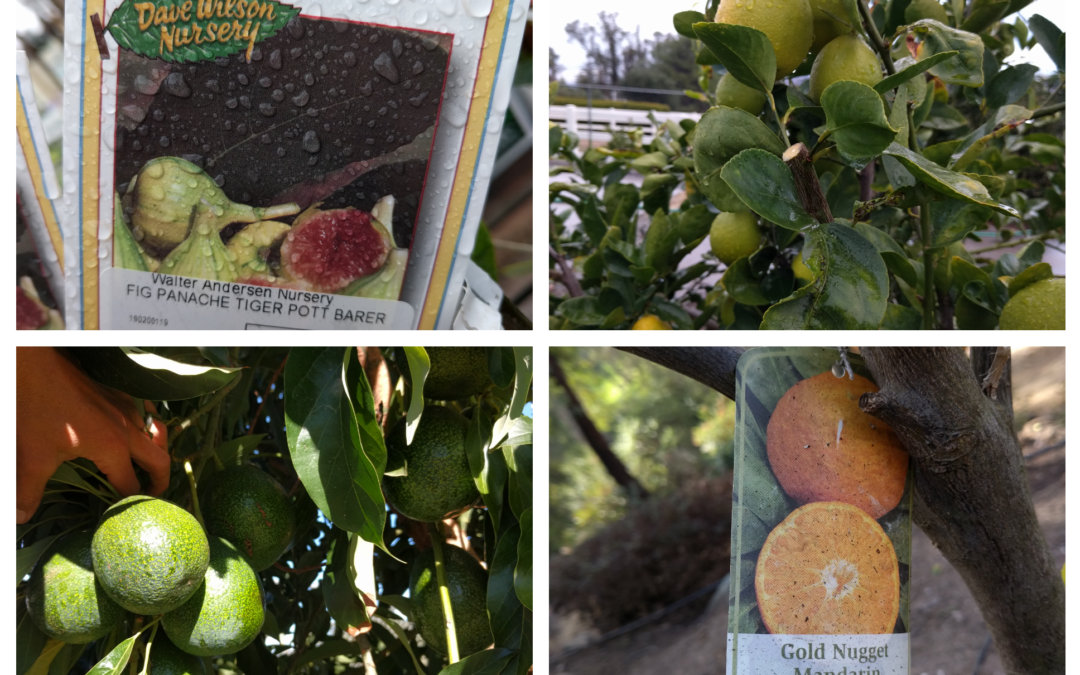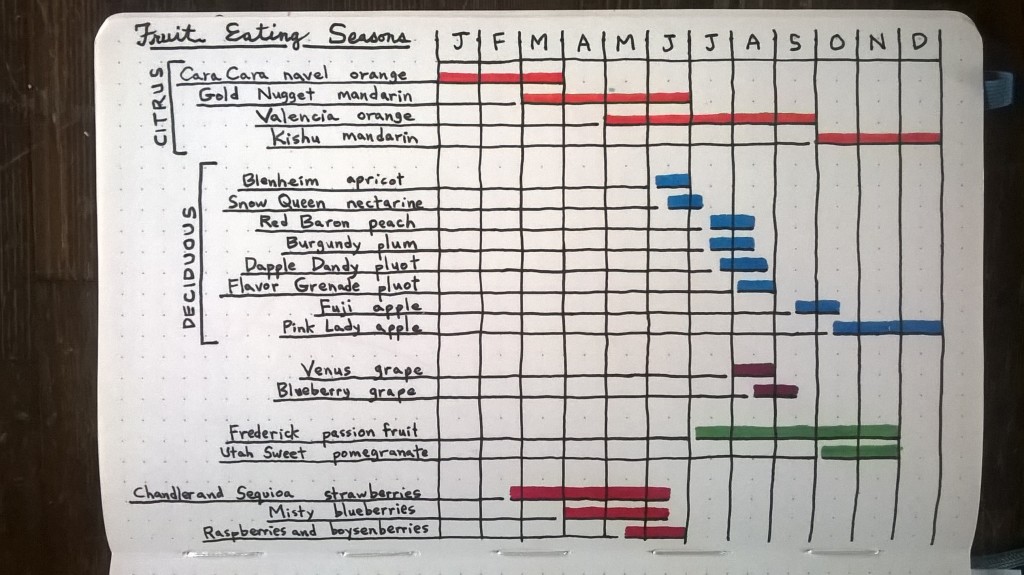There are so many options. In Southern California, we can grow pears, bananas, oranges, persimmons, figs, peaches, plums, nectarines, jujubes, cherimoyas, sapotes, pomegranates, tangerines, grapefruit, apricots, pluots, mangos, just to name a few. How do you choose?
Over the years I’ve developed a process that has led to choices that I remain happy with today. First, there are the three most important factors to consider:
- What do you eat?
- Which trees are well-suited to your yard?
- When do you want to eat the fruit?
Then there are a couple of less critical but still worthwhile things to think about:
- How much effort are you willing to give the tree?
- Would you like the tree to provide shade or privacy too?
As you work your way down the list, you ought to eliminate options until you end up with the fruit tree(s) that are best for you. What’s best for you is not what’s best for me or your friends (assuming I’m not one of your friends), but to wrap up the post I’ll demonstrate how I recently ran through this process to make a choice for my yard.
So to start, which kinds of fruit do you eat — regularly? You don’t want a tree full of white sapotes if you only want to eat a couple every now and then. And also think about which kinds of fruit you would eat if only you could. Maybe you know that you love apricots because you used to eat them from the tree in your grandparents’ yard, but you never eat them anymore because whenever they’re available at the grocery store they’re tart or tasteless. You would eat apricots regularly if only you had a tree full of them in your yard.
Now, out of the fruit you eat, which kinds are well suited to the environmental conditions of your yard? When thinking about this, consider how cold it is in the winter as well as how hot it is in the summer. If you live close to the beach, bananas will probably do well in your yard but apricots might not. The opposite is true if you live where I do, about twenty miles from the beach. In the environment of my yard, bananas don’t do great because of the handful of winter nights in the 30s, but apricots love that and they produce like crazy here.
Also, think of how many hours of unimpeded sunlight your yard gets. If the place for your tree only gets full sun for a few hours each day, you might be able to grow acceptable lemons but probably not excellent, sweet pluots. In general, fruit trees want to bathe in the sun all day long.
How do you know what environmental conditions different fruit trees prefer? Consult the Sunset Western Garden Book (for all kinds of fruit trees) or Dave Wilson Nursery (for winter chill guidance on deciduous fruit trees), or best of all, note which fruit trees are doing well in the yards of your neighbors. Your own observations trump all other opinions.
The third critical thing to consider is when you want the fruit on your tree to ripen. These days it’s hard to know the seasons of fruit varieties because grocery stores make them available all year by importing from abroad. We can buy navel oranges from Australia in August, but navel oranges from a tree in your yard in Southern California will taste terrible in August. Rediscover when different kinds of fruit ripen in our part of the world by consulting the Sunset Western Garden Book or Dave Wilson’s Harvest Chart (for deciduous fruit trees), or for avocados and citrus have a look at this chart from Maddock Nursery in Fallbrook (one mistake on the chart is that the Gold Nugget mandarin season does not start in January but rather in about March).
(Also see my post, “Fruit trees for a year-round harvest in Southern California.”)
But why is it important to know when a particular fruit tree will have ripe fruit? So you don’t miss out. If you go on vacation every July and plant a Red Baron peach tree, you’ll likely never taste its fruit. Every year you’ll return from vacation to find a hundred peaches rotting on the ground. Or, you may already have some fruit trees in your yard. In that case, you’ll probably want to add to your orchard with a tree that won’t ripen its fruit at the same time as a tree you already have. If you have a Fuyu persimmon tree providing you fruit in the fall, then get a Valencia orange to provide you fruit in spring and summer. Spread your harvest season rather than concentrate it.
Still have many options left? Think about these less critical factors:
How much effort are you willing to give the tree? For example, do you want the responsibility of pruning? Peaches, nectarines, plums, pluots, and apricots pretty much have to be pruned yearly. If they aren’t, they’ll end up with broken branches or sunburned bark or fruit that must be picked from a ladder because the tree is 20 feet tall. On the other extreme, you can plant a pomegranate and never prune it and you will continue to get fruit that is within reach.
Are you willing to be careful about irrigation? If you plant an avocado and carelessly water it, the tree will possibly die or at best give you few fruit. Then there are jujubes, which will do fine without any irrigation at all. All other fruit trees’ irrigation needs lie somewhere between those extremes.
Would you like the tree to provide privacy or shade too? It’s always nice to kill two birds with one stone — the two birds being fruit plus privacy or shade. A deciduous fruit tree like a nectarine could provide fruit and shade. But remember that deciduous fruit trees won’t provide year-round privacy. If you want fruit, privacy and shade — three birds! — then your best choice is an evergreen like citrus or avocado.
Well, what’s left for you? Which kinds of fruit trees fill your needs? What’s the best fruit tree or trees for you and your family, in your yard specifically?
Let me tie everything together by giving you the ideas that went through my head while considering the above factors when making a decision about which kind of fruit tree to plant in our yard last year.
We already had many different kinds of fruit trees in the yard, but only one apple, a Pink Lady, planted the previous year. As a family, we have always eaten lots of apples, so I was thinking we would add another. We often bought Granny Smith, Fuji, Gala or Braeburn at the grocery store. Out of those varieties, Braeburn was the only one said by Kevin Hauser of Kuffel Creek apple nursery in Riverside to not do well in Southern California. Braeburn was eliminated. We had a relative scarcity of fruit coming from our yard in the period of late August through October, so I wanted the new apple tree to ripen its fruit in that window if possible. Granny Smith is ripe about the same time as our Pink Lady, from about October on through the end of the year. That’s not good. Gala is ripe earlier, around August. That might work. Fuji starts in September and certainly lasts through October. Fuji fit our needs closest. So I chose to plant a Fuji — right beside the Pink Lady.
What will you plant?






It looks like your apple trees are planted fairly close together. is it easy to keep them small, even for beginners?
Hi Tasha,
Yes, I planted the apples 3-4 feet apart. They’re only about four years old now, but I haven’t had any problems keeping them growing within their allotted space by pruning. Apples don’t grow that vigorously in Southern California. Once or twice a year I’ve just trimmed them back so one doesn’t overwhelm the other (the Fuji is the one that spreads more of these two trees). This doesn’t take any real skill. You just use a pair of pruners and cut back branches to the desired length.
Maybe you’d like to read this post: https://gregalder.com/yardposts/my-best-advice-on-pruning-deciduous-fruit-trees-keep-them-small/
Greg: do you have a reference I can search about growing fruit trees in Ramona?
Hi Tom,
I can’t point to a single resource on that, but I have a sense of how different fruit trees perform in different parts of Ramona because I’ve been out and about observing them closely for the last dozen years. Since it’s such a large and varied area, there are high spots that almost never see frost on the ground and low or flat spots that see frost almost every winter morning. In other words, some parts of Ramona feel like Julian to a fruit tree whereas others feel like Mira Mesa. Let me know if you have specific questions and I’ll do my best to connect you with someone who grows fruit trees in a similar part of Ramona to you so they can share their firsthand experience. I’m sure we can find someone, as there are lots of Ramona gardeners who read the Yard Posts.
Hi Greg,
Have you seen anyone have success with an almond or other nut tree variety in Ramona? I’ve met some people who had luck down in Lemon Grove.
Hi Mikayla,
Here in Ramona, a neighbor has a couple of almonds that produce well, and another neighbor has macadamias that produce very well (my macadamia does well too). There is also a neighbor with a walnut and another neighbor with some pistachios, but I have only seen the trees from afar; I’ve seen that they carry a crop, but I don’t know if the harvested nuts (fruit) actually have good fill. I will ask them when I get a chance.